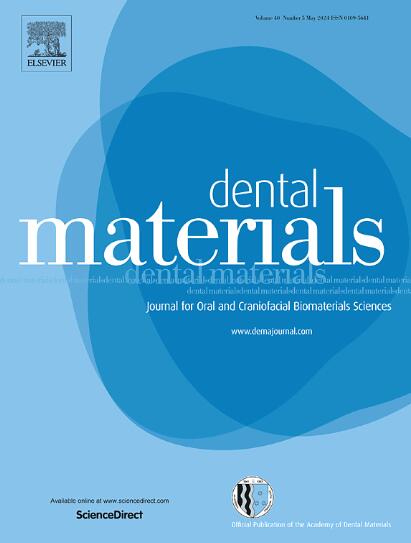模拟临床相关条件下种植体与基台界面的冻蚀。
IF 4.6
1区 医学
Q1 DENTISTRY, ORAL SURGERY & MEDICINE
引用次数: 0
摘要
目的:种植治疗适用于咀嚼力正常、理想的患者,也适用于有磨牙、咬紧牙和磨牙等副功能性习惯的患者。牙蚀是一种常见的日趋严重的病症,据报道,32%的成年人都会受到牙蚀的影响,并且随着年龄的增长而增加。这种口腔环境有利于摩擦腐蚀,并可能导致种植体表面和修复组件界面的材料流失。虽然已有一些摩擦腐蚀的研究报道,但到目前为止,还没有研究模拟过与临床相关的微动。因此,我们的目的是使用新型微摩擦腐蚀系统研究摩擦腐蚀,模拟在不同咬合负荷和酸性暴露条件下种植体与基台界面 5 µm 运动的临床条件:我们通过改变接触负荷(83 N 和 233 N)和 pH 值(3 和 6.5)模拟了口腔环境中的四种情况。我们选择了常用的种植体材料 IV 级钛和基台材料氧化锆(ZrO2)/ IV 级钛作为测试材料。采用人工唾液代表口腔环境。此外,还遵循了标准的磨蚀协议,并控制针在咀嚼阶段在圆盘上以 5 μm 的振幅摆动。测试结束后,利用三维轮廓仪和扫描电子显微镜(SEM)以及能量色散光谱仪(EDS)对磨损表面进行分析。电感耦合等离子体质谱法(ICP-MS)也用于测量金属离子释放量:结果:能量比低于 0.2,表明所有组都存在部分滑移的退火机制。对开路电位(OCP)和电化学阻抗谱(EIS)进行了分析,以比较各组之间的电化学行为。结果发现,Ti4-Ti4 组的腐蚀性损伤比 Zr-Ti4 组更严重,而 Zr-Ti4 组的机械损伤比 Ti4-Ti4 组更严重。讨论中提出了解释这些发现的可能机制:本研究的结果可能有助于临床医生选择种植体。例如,对于磨牙症患者来说,钛种植体与钛基台搭配可能更合适,而胃食管反流症患者则可能从钛种植体与氧化锆基台搭配中获益更多。本文章由计算机程序翻译,如有差异,请以英文原文为准。
Fretting-corrosion at the Implant–Abutment Interface Simulating Clinically Relevant Conditions
Objective
Implant treatment is provided to individuals with normal, idealized masticatory forces and also to patients with parafunctional habits such as grinding, clenching, and bruxing. Dental erosion is a common increasing condition and is reported to affect 32 % of adults, increasing with age. This oral environment is conducive to tribocorrosion and the potential loss of materials from the implant surfaces and interfaces with prosthetic components. Although several fretting-corrosion studies have been reported, until now, no study has simulated clinically relevant micromotion. Therefore, our aim is to investigate fretting-corrosion using our new micro-fretting corrosion system, simulating clinical conditions with 5 µm motion at the implant-abutment interface under various occlusal loads and acidic exposures.
Methods
We simulated four conditions in an oral environment by varying the contact load (83 N and 233 N) and pH levels (3 and 6.5). The commonly used dental implant material, Grade IV titanium, and abutment material Zirconia (ZrO2)/ Grade IV titanium were selected as testing couple materials. Artificial saliva was employed to represent an oral environment. In addition, a standard tribocorrosion protocol was followed, and the pin was controlled to oscillate on the disk with an amplitude of 5 m during the mastication stage. After the testing, 3D profilometry and scanning electron microscopy (SEM) with energy dispersive spectroscopy (EDS) were utilized to analyze the worn surfaces. Inductively coupled plasma mass spectrometry (ICP-MS) was also used to measure the metal ion release.
Results
Energy ratios were below 0.2, indicating a fretting regime of partial slip for all groups. Open-circuit potential (OCP) and electrochemical impedance spectroscopy (EIS) were analyzed to compare the electrochemical behavior among groups. As a result, corrosive damage was observed to be more in the Ti4- Ti4 groups than in Zr-Ti4 ones, whereas more mechanical damage was found in the Zr-Ti4 groups than in the Ti4-Ti4 groups. Possible mechanisms were proposed in the discussion to explain these findings.
Significance
The results observed from this study might be helpful to clinicians with implant selection. For example, for patients with bruxism, a titanium implant paired with a titanium abutment may be preferable, while patients with GERD may benefit more from a titanium implant paired with a zirconia abutment.
求助全文
通过发布文献求助,成功后即可免费获取论文全文。
去求助
来源期刊

Dental Materials
工程技术-材料科学:生物材料
CiteScore
9.80
自引率
10.00%
发文量
290
审稿时长
67 days
期刊介绍:
Dental Materials publishes original research, review articles, and short communications.
Academy of Dental Materials members click here to register for free access to Dental Materials online.
The principal aim of Dental Materials is to promote rapid communication of scientific information between academia, industry, and the dental practitioner. Original Manuscripts on clinical and laboratory research of basic and applied character which focus on the properties or performance of dental materials or the reaction of host tissues to materials are given priority publication. Other acceptable topics include application technology in clinical dentistry and dental laboratory technology.
Comprehensive reviews and editorial commentaries on pertinent subjects will be considered.
 求助内容:
求助内容: 应助结果提醒方式:
应助结果提醒方式:


